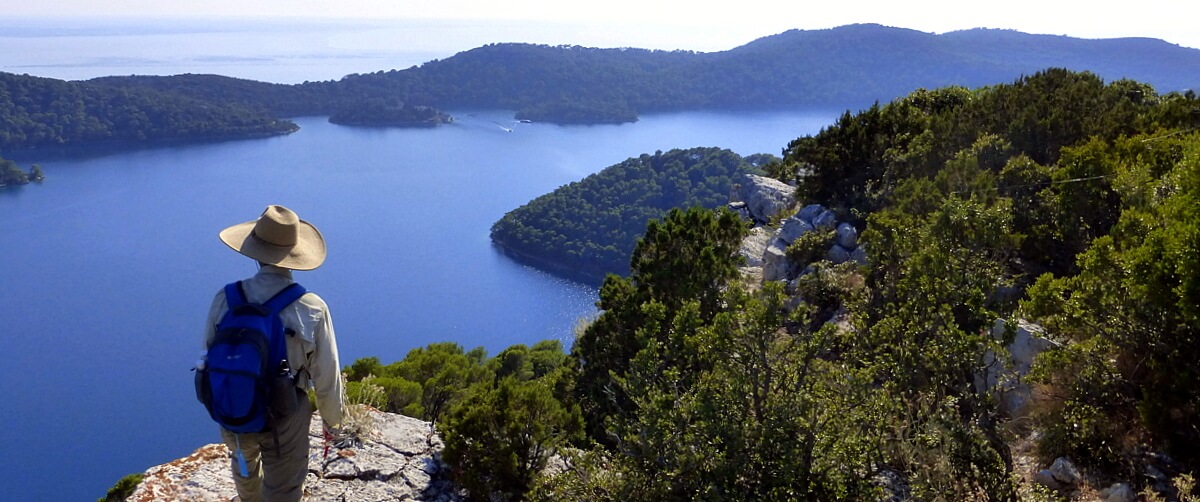We arrived into Hvar Town on the island of Hvar around 3 pm. Immediately we were reminded that this is the hot spot of the Adriatic for the booze cruise crowd. Tourists abounded and the average age was about 12, maybe just a little older. Our fellow travelers from the Adriatic Pearl headed off on a guided tour to learn this chapter of Dalmatian history. Scott and I stayed with them for a couple of stops before finding a rental car agency.
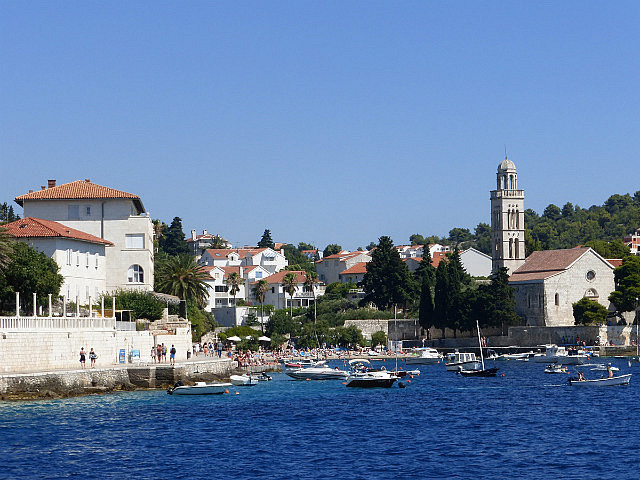
Though lacking the requisite credit card deposit, this rental experience was slightly more conventional/digital than our last on the island of Korcula, In this case, however, we paid a 50 Ku deposit to the first salesperson with whom we met, were then led around the corner to pay the balance of the payment – 450 Ku – to a second different agency, and were given a third location near the bus station to actually present our contract and pick up the car.
Soon we were headed out of town, Scott again behind the wheel. Within a kilometer, we rounded a curve and found a speeding motorbike pointed directly at us, well over onto our side of the line. Island roads are already narrow without the encroachment of oncoming motorists using more than their share. He swerved right and Scott moved right as far as he could, but an outcropping of rock limited his ability to adjust. Fortunately, no contact was made and we continued up the country road, hearts beating just a tad quicker.
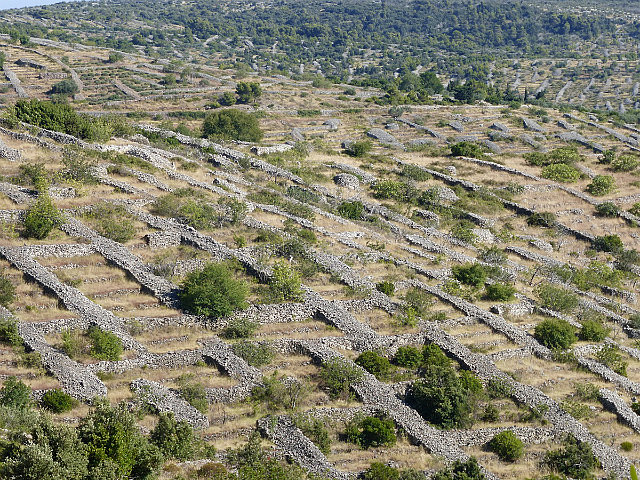
As soon as we left the jet set behind in Hvar, we entered what felt like a completely different island. A recurring theme of the Dalmatian story is the parade of civilizations that have laid claim to these sun-kissed islands at one point or the other over the past three millennia. Within 5 km, we were high above the coastline, looking across miles of desolate-looking fields checkerboarded with stone walls. How many man-hours were devoted to developing the land on these rock-filled islands? Stone has to go somewhere, so walls are built, partly to subdivide the land and partly to dispose of the rocks.
While towns and cities seem to be destroyed by succeeding conquerors, the work in the fields seems to be borrowed and built upon, hence century upon century of wall building. Our guide told us that the area on the north side to which we were headed retained some of the most unaltered farming walls, going back to pre-Roman Greek settlement.
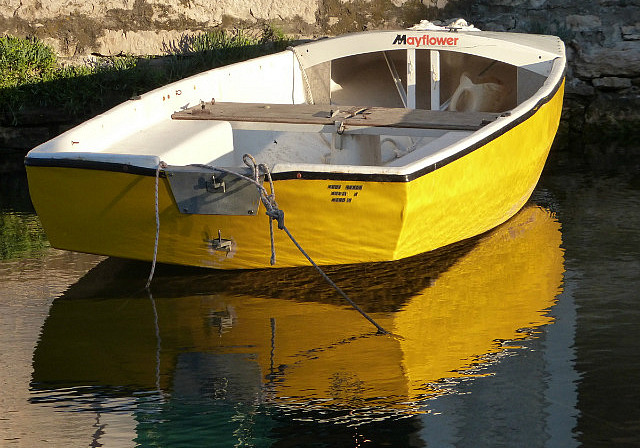
We’d also learned that the center of the island suffered greatly from crop disease in the 1920s. Vineyards upon which much of the economy was based were devastated throughout Europe, and Dalmatia was not immune. Multitudes of Dalmatians immigrated, to Australia, to the USA, to South America. Some of the inland towns are still virtually deserted.
As we dropped down onto the northern plans of Hvar, the terrain became greener and healthy vineyards dotted the land. Our course took us through a trio of small villages, prospecting for trail possibilities. We made one false start, parking our car in one village and heading up the hill for 15 minutes before abandoning the attempt.
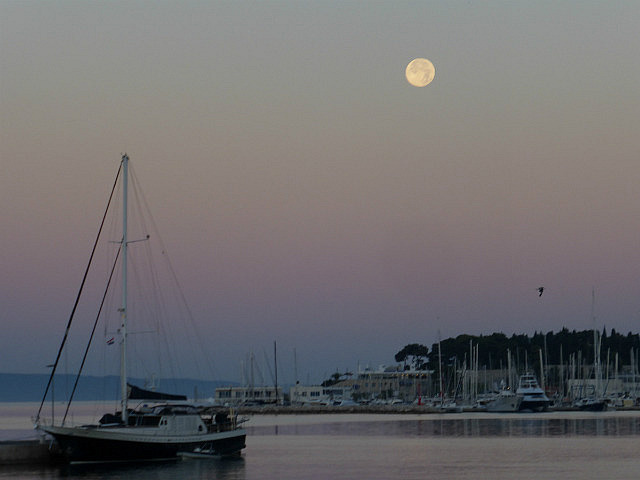
Our fallback plan was a walk between the coastal towns of Vrboska and Jelsa, and as the clock moved towards 6 pm, we pointed the car towards Vrboska where a long narrow finger of the sea juts into the island of Hvar here. We found the northwest edge of the channel and worked our way down a seaside walkway towards the center of town.
The maritime nature of Dalmatia is inescapable, but here on the north side of the island, the boats bring a different kind of visitor. Many of those enjoying the evening ambiance of Vrboska seemed to be Croatian, and if not Croatian, European. Hvar Town, by contrast, was full of English speaking tourists. Australians and New Zealanders have discovered the Adriatic, and during the summer, young Americans are coming in droves as well.

We wrapped around the narrowing channel, crossed by three progressively smaller bridges. The route passed all manner of boats, including a forest of sailboats, before leaving town and weaving along the coast towards neighboring Jelsa. Joggers, walkers, and bicyclists shared the road, with non-stop views out over the Adriatic to the rugged mountains of neighboring Brač, brushed with hues of pink from the setting sun.
We rounded the bend into Jelsa just as dusk was falling. The waterfront was typical of towns we’ve encountered, full of pleasure craft with a few fishing boats, and busy with the evening flow of people enjoying summer in the islands. Again, however, on this side of the island the people present appeared local. On the edge of the harbor, a delightful little square sat in the shadow of the church steeple, ringed with busy cafes and restaurants.
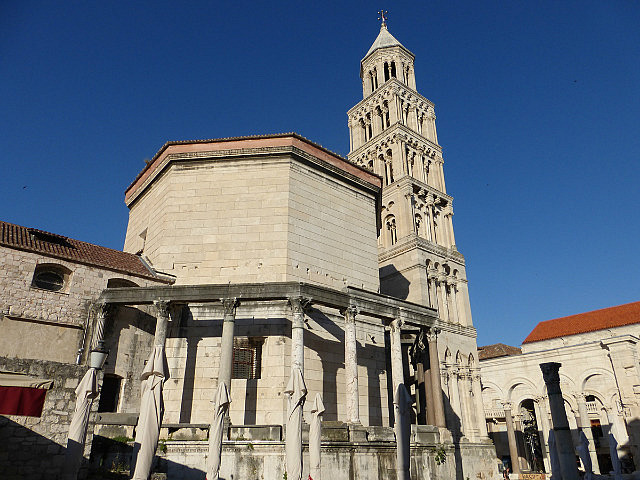
We made final walk notes, snapped a few photos, and enjoyed the happy hum of humanity before climbing back in our rental car and heading across the island in the dark. We returned to Hvar intent on filling the gas tank then calling our contact to drop the car. The town of Hvar has only one gas station, however, and it is NOT situated en route to anywhere. A couple of turns took us to the outskirts of town where we found the gas station, in the dark. We’d forgotten that it closes at 9 pm. Not a problem – we called the rental car agency owner and arranged for the drop. He charged us the equivalent of $12 for the gas we’d used during the afternoon, one of the best bargains of the trip to date.
Dinner onboard ship was long since finished, so Scott and I found a table at a local pizzeria and celebrated another successful walk-planning afternoon with a bottle of wine and Dalmatian-style pizza![/vc_column_text][/vc_column][/vc_row][vc_row][vc_column][vc_gallery interval=”0″ images=”6813,6817,6806,6820,6807,6809,6810,6811,6808″ img_size=”large”][/vc_column][/vc_row]

